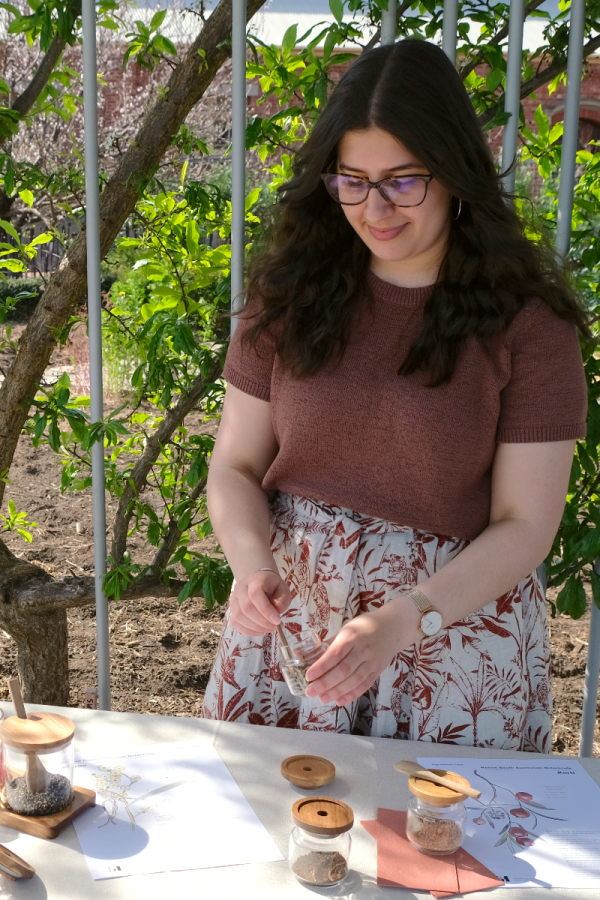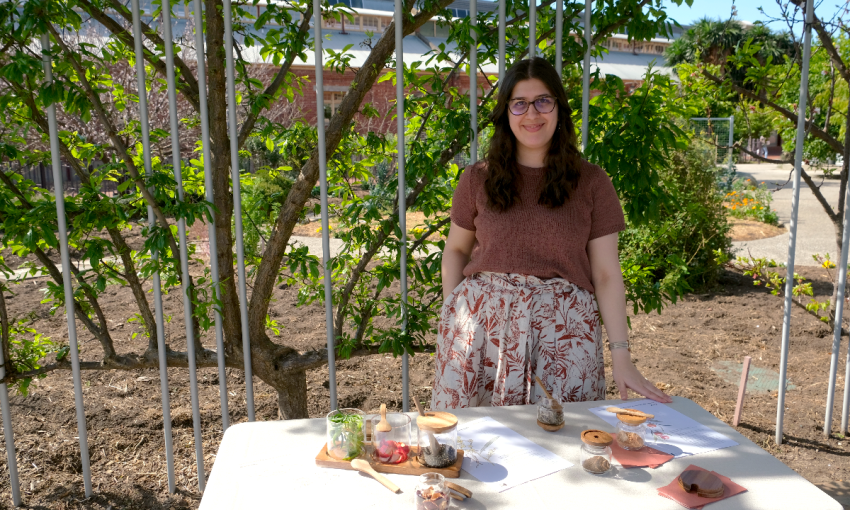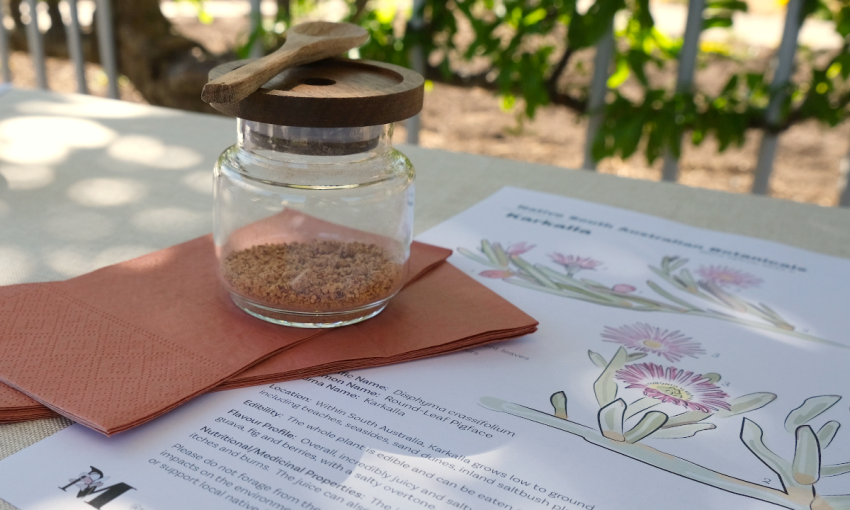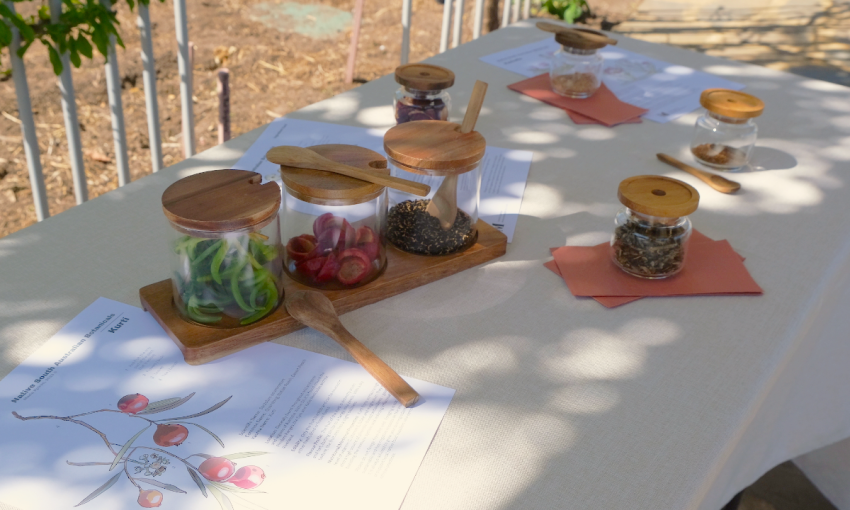Maria Ppiros has always loved Kaurna land and the incredible plants it sprouts. Now, she is using her research to bring other South Australians closer to their natural world through their stomachs.
Let’s not be naïve to natives
There is a special treat in the Adelaide Botanic Gardens’ Little Sprouts Kitchen Garden when CityMag visits on a sunny spring afternoon.
A trestle table is set up under the veranda and covered with jars of plants, seeds and powders.
“So, which would you like to try first?” Maria Ppiros asks with a smile, gesturing to the jars.
A researcher and PhD candidate at the University of South Australia, Maria is finding new ways to educate people about native botanicals – specifically those you can eat.
“Native ingredients can be very daunting for people who might not know much about them,” she says. “So, I am looking at how I can create pedagogical (aka educational) tools that look at botanical illustrations and how they can communicate information to people in a way that is direct and comprehensible.” 

Maria really knows her natives
Drawing on skills gained from her Bachelor of Design (First-Class Honours), Maria has created a series of illustrated botanical ingredient cards designed to teach the essentials of plants native to Kaurna land.
Each card has a detailed illustration – designed to be “less rigid and formal” than traditional botanical illustrations – alongside naming protocols, health benefits, medicinal purposes, recipes and information on where and how they grow.
“I also have a disclaimer on my cards discouraging wild foraging as there is so much out there these days about foraging and I think it is a little bit problematic – especially when we are talking about trying to protect and conserve native species because, as fun as it might seem, the truth is that foraging is not a sustainable option and has negative impacts on the environment,” Maria says.
“We need to think about sustainability and the environment and, just as importantly, our health.
“When you’re foraging, you don’t know if a plant has been sprayed or if there is a parasite on it. You need to think of it in a way where, like, you wouldn’t just go and eat anything else off the side of the road.”
Maria recommends heading to a local nursery and purchasing a native plant that you can nurture in your own garden. Some native edibles, like karkalla (pigface), can even be grown in pots indoors.
She also says there are plenty of great local and online stores that sell native ingredients both in their natural, fresh form or in treated ways such as roasted, powdered or dried.
CityMag has a taste of some of these plants in all their varieties – savouring the first crunch of karkalla as teeth sink into the succulent, breathing in the aromatic roasted grounds of golden wattle seeds and marvelling at the endless combinations when cooking with quandongs. (quandongs + pistachio = 🤤)

Some little sprouts at Little Sprouts
To test her botanical illustration cards, Maria is hosting a series of 2.5 hour workshops at the Adelaide Botanic Gardens – the first of which was held last Wednesday and the next tomorrow.
Throughout the $30 workshop, participants are invited to engage with native edibles, try out some recipes and create botanical illustrations to help educate them on native plants and increase their connection with nature.
“The first activity is about getting people to actually, like, stop and look at the plants; to relax and take notes on what they can see, feel, smell and taste,” Maria says.
“We have something called ‘plant blindness’ in our society today, which essentially means there is a plant there but people just walk by it and don’t really acknowledge it.
“I want people to reengage with the nature surrounding them.”
The group is then taken through a live cooking demonstration with Gather chef and owner Tom Tilbury that provides a literal taste of how native edibles can be cooked and prepared, with ingredients donated by Andrew Fielke of Creative Native Foods.
The final part of the workshop sees participants drawing their own botanical illustrations: “It isn’t a ‘here you go, now draw it’ type of thing – we do start with some warm-up activities,” Maria says.
“One is called a ‘blind continuous line drawing’ where you don’t look at the page – you focus completely on your specimen – and you draw your cutting or plant without looking at the paper while you do it.”
Maria hopes that workshop participants have fun and leave having learned something new.
“I think it is important that, wherever you live, you know about the environment around you,” Maria says. “You don’t have to be an expert, but don’t be naïve about the plants in your backyard – I think having that knowledge makes for a better world.”

“pre-mix”
As this project focusses on native Australian flora and Aboriginal Australian ethnobotany, and Maria does not identify as Aboriginal and/or Torres Strait Islander, she always ensures that the Cultural Interface Protocols for Engaging with Aboriginal Knowledge are followed and also acknowledges the owners of the knowledge in this project. To ensure this, she consults with a panel of advisors which includes Aboriginal Australian advisors.







